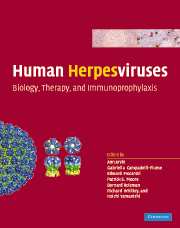Book contents
- Frontmatter
- Contents
- List of contributors
- Preface
- Part I Introduction: definition and classification of the human herpesviruses
- Part II Basic virology and viral gene effects on host cell functions: alphaherpesviruses
- Part II Basic virology and viral gene effects on host cell functions: betaherpesviruses
- Part II Basic virology and viral gene effects on host cell functions: gammaherpesviruses
- Part III Pathogenesis, clinical disease, host response, and epidemiology: HSV-1 and HSV-2
- Part III Pathogenesis, clinical disease, host response, and epidemiology: VZU
- Part III Pathogenesis, clinical disease, host response, and epidemiology: HCMV
- Part III Pathogenesis, clinical disease, host response, and epidemiology: HHV- 6A, 6B, and 7
- Part III Pathogenesis, clinical disease, host response, and epidemiology: gammaherpesviruses
- Part IV Non-human primate herpesviruses
- Part V Subversion of adaptive immunity
- Part VI Antiviral therapy
- 64 Antiviral therapy of HSV-1 and -2
- 65 Antiviral therapy of varicella-zoster virus infections
- 66 Antiviral therapy for human cytomegalovirus
- 67 New approaches to antiviral drug discovery (genomics/proteomics)
- 68 Candidate anti-herpesviral drugs; mechanisms of action and resistance
- Part VII Vaccines and immunothgerapy
- Part VIII Herpes as therapeutic agents
- Index
- Plate section
- References
65 - Antiviral therapy of varicella-zoster virus infections
from Part VI - Antiviral therapy
Published online by Cambridge University Press: 24 December 2009
- Frontmatter
- Contents
- List of contributors
- Preface
- Part I Introduction: definition and classification of the human herpesviruses
- Part II Basic virology and viral gene effects on host cell functions: alphaherpesviruses
- Part II Basic virology and viral gene effects on host cell functions: betaherpesviruses
- Part II Basic virology and viral gene effects on host cell functions: gammaherpesviruses
- Part III Pathogenesis, clinical disease, host response, and epidemiology: HSV-1 and HSV-2
- Part III Pathogenesis, clinical disease, host response, and epidemiology: VZU
- Part III Pathogenesis, clinical disease, host response, and epidemiology: HCMV
- Part III Pathogenesis, clinical disease, host response, and epidemiology: HHV- 6A, 6B, and 7
- Part III Pathogenesis, clinical disease, host response, and epidemiology: gammaherpesviruses
- Part IV Non-human primate herpesviruses
- Part V Subversion of adaptive immunity
- Part VI Antiviral therapy
- 64 Antiviral therapy of HSV-1 and -2
- 65 Antiviral therapy of varicella-zoster virus infections
- 66 Antiviral therapy for human cytomegalovirus
- 67 New approaches to antiviral drug discovery (genomics/proteomics)
- 68 Candidate anti-herpesviral drugs; mechanisms of action and resistance
- Part VII Vaccines and immunothgerapy
- Part VIII Herpes as therapeutic agents
- Index
- Plate section
- References
Summary
Introduction
Primary infection caused by varicella-zoster virus (VZV) is manifest by varicella (chickenpox), while reactivation of latent virus causes herpes zoster (shingles). In immunocompetent children, varicella is usually not a serious disease, but can cause severe morbidity and mortality in adults and in immunocompromised individuals. Similarly, herpes zoster is associated with much greater morbidity in patients with impaired cell-mediated immune responses. In addition, herpes zoster can cause prolonged pain (postherpetic neuralgia) that can be very difficult to manage, particularly in older individuals. The outcomes of varicella and herpes zoster, especially in immunocompromised patients, have been dramatically improved by the development of safe and effective antiviral drugs with potent activity against VZV. Early drugs with modest efficacy and substantial toxicity (e.g., interferon, vidarabine, etc.) have been replaced by antiviral agents with enhanced in vitro activity, improved pharmacokinetic properties, and excellent safety profiles.
Diagnosis
Most experienced physicians will be able to make an accurate clinical diagnosis of chickenpox based on the distinctive appearance of the skin lesions (Fig. 65.1(a)). The clinical syndrome of a child with mild constitutional symptoms, the typical diffuse vesicular rash, and no prior history of chickenpox is strongly suggestive of the diagnosis, especially if there has been exposure to VZV within the previous two weeks. However, in countries where the incidence of varicella is dramatically declining (such as the United States), younger physicians will have fewer opportunities to see patients with chickenpox and may feel less confident with the clinical diagnosis.
- Type
- Chapter
- Information
- Human HerpesvirusesBiology, Therapy, and Immunoprophylaxis, pp. 1175 - 1191Publisher: Cambridge University PressPrint publication year: 2007
References
- 11
- Cited by

